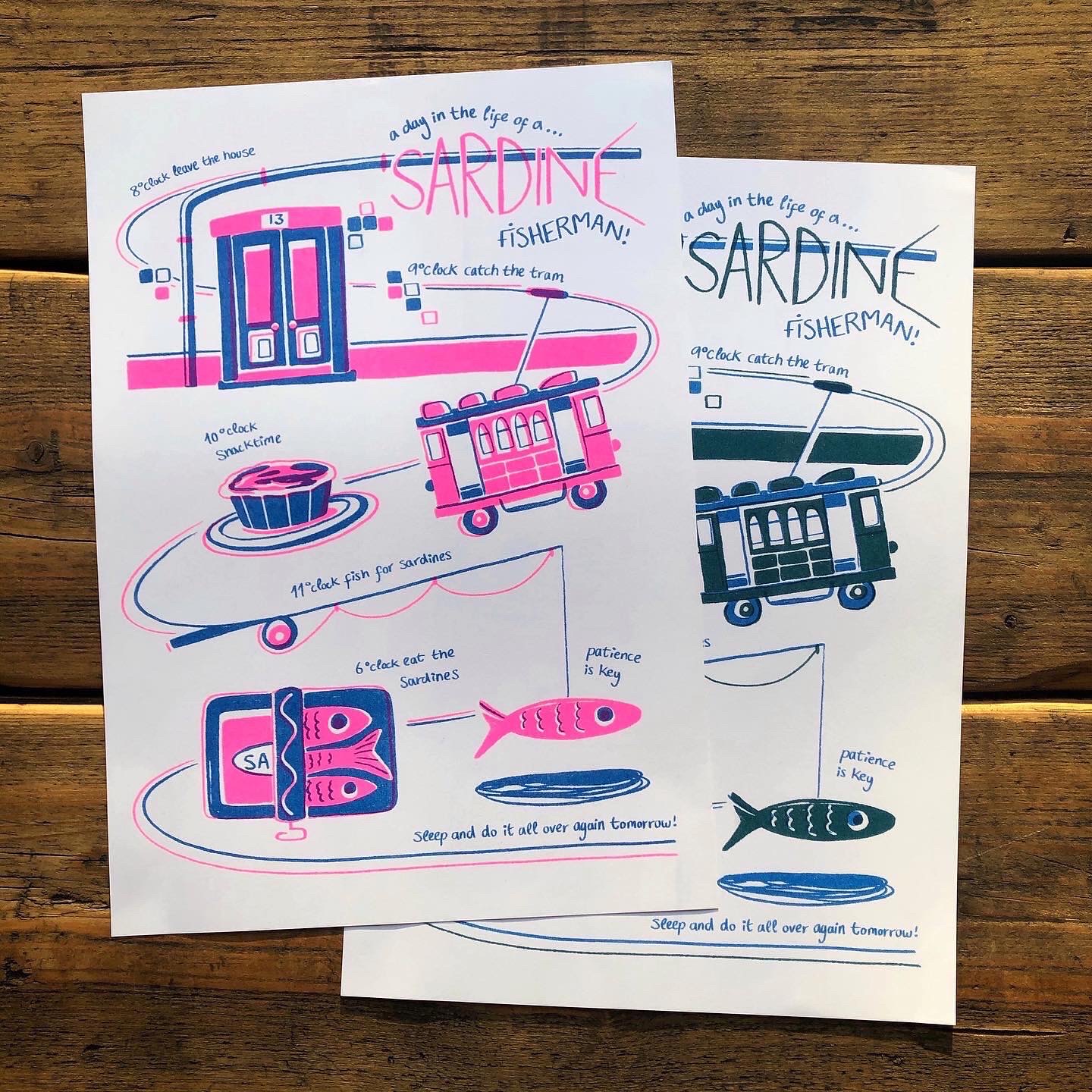Processes and Practice Reflections and SWOT Analysis
I've always been interested in the diversity of Portuguese identity. From the traditional houses with terracotta roofs, hand-painted tiles and decorative doors, to the history of sardines dating back to the early 1900s. Everything in Portugal has a history and has been beautifully designed and crafted, there's so much to be inspired by which is why I chose it. Sardines, as well as trams and houses are some of the features I tried to communicate through print in this project, I wanted to take inspiration from iconography while combining it with Riso and monoprinting processes. Luckily I could access the Risoprinter in the studio so I enjoyed using it more regularly to experiment with colour and composition.
Based on my research and photos, I made a 'Day in the Life of a Sardine Fisherman' risoprint, showing the daily cycle of a sardine fisherman (or an interpretation based on what I've seen on the beach!), catching the tram, eating a Pastel de Nata, fishing and finishing the day with sardines. Below you can see the finished two-colour risoprint- I was happy with how this one turned out! One of the main things I've learnt through this experimentation is not to put too much pressure on myself for the outcome to be perfect as it’s an unpredictable printing process and the imperfections are usually what makes it more satisfying.
Over the past few weeks, I’ve loved experimenting with monoprint, risoprint, lino prints as well as learning some new techniques like dendritic monoprint and making a laser-cut relief plate. I got to research and respond to some of my favourite printmakers Meg Fatherly and Nat Andrewson, two artists I follow on Instagram and continue to be inspired by and learn from. In response, the Meg Fatherly, I tried a new paper-cut monoprint process by cutting shapes out on my Cricut and placing them on an inked surface to create one-off prints. This was such a rewarding process and some of my favourite things to come from this project. I was thinking of making them into A5 prints for the imaginary Etsy shop I'll hopefully have in the future! They'd make a good set- something to come back to later now that I know about it.
The diversity of print and the commercial aspect has always interested me, print can be mass-produced but still have a handmade finish. Through this project, I've developed a good understanding of print companies, such as 'We Are Out of Office' and 'People of Print'. Companies among many others who create independent and commercial work for use in advertising and merchandising, helping to keep traditional printing methods alive and showcase their importance in an ever-evolving digital world. Through this project, I've tried many processes, making the most of time in the studio to produce risoprints, relief prints and participate in digital workshops, enabling me to produce a large body of work. I've really enjoyed having the freedom and time to experiment with printing processes as print is one of my favourite practices and one I continue to learn more about.
Strengths-
- Making an action plan at the beginning to make sure I covered many processes, focusing on new ones each week.
- Good annotation and use of SWOT Analysis' in my sketchbook to assess what worked well, especially with Riso when testing colour combinations and creating assets suited to the process.
- Produced a good body of work that can be used in my portfolio or made into prints, developed a lot of new skills.
- Managing time efficiently, balanced between research and practical work making use of studio access.
- Trial and error! Leaning that traditional print can be time-consuming and not turn out as expected.
Weaknesses-
- Could have compiled more research of Print companies in the initial stages which would have provided a stronger starting point. Might have taken me down different avenues.
- Less consistent blog posts, I should have posted more weekly updates.
Opportunities-
- Opportunity to reproduce prints for a commercial purpose, possibly to sell one day or add to my portfolio showing a wider skillset.
- They would be well suited to the art galleries and tourist shops, targeted at tourists/buyers looking for unique and contemporary souvenirs so I could take some next time I visit.
Threats-
- A lot of time spent experimenting with layers and colours on the risograph printer, took up studio time.
- Not enough artist research relevant to the project title, 'Processes and Practice' so I could get a lower grade for not including more about print companies and artists in the print industry.







Comments
Post a Comment